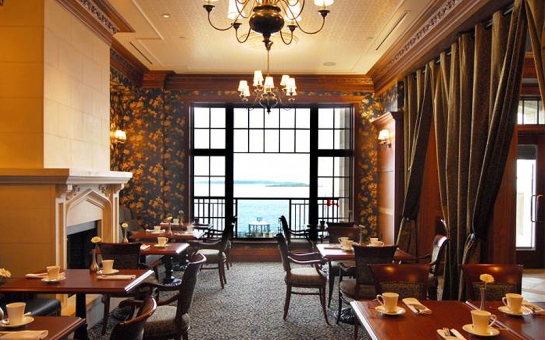
Left to right: Sharon Bortolotto (moderator), Alessandro Munge (Munge Leung), Cynthia Penner (Box Interior Design), Vicki Pearson (Porada)
What makes an interior space successful when it comes to hotels, restaurants, bars and clubs? What is there to know about hospitality design? How are top firms designing for today and for the future? Here are my key takeaways from the interior design keynote panel at Buildex Vancouver 2014.
1.
Cynthia Penner of Box Interior Design shared the thought process behind the concept of Black and Blue. The restaurant creates a scene with a darker, provocative colour palette. Everything from changing the tenor with materials and design, to the guest experience, adds to the value of the atmosphere, making the venue a place to see and be seen.

Box Design and Inform Interiors came together to create an aesthetically pleasing focal point with Tom Dixon’s etch metallic frames. The light installation features 86 gold shades, located centrally in the restaurant.
2.
 Munge Leung, a Toronto based boutique design firm, focuses on luxury condominium developments, restaurants, resorts and nightclubs. 1 Oak, located in the Mirage Resort and Casino in Las Vegas boasts graphic prints, textures and bold colours.
Munge Leung, a Toronto based boutique design firm, focuses on luxury condominium developments, restaurants, resorts and nightclubs. 1 Oak, located in the Mirage Resort and Casino in Las Vegas boasts graphic prints, textures and bold colours.
Hotels are “no longer a place to sleep until you get to the next place”. Hotels are becoming more of a destination, somewhere to experience and enjoy, with amenities like spas, fitness studios, open rooftops, bars and restaurants. Boardrooms and meeting areas are incorporated into the space plan to accommodate the guest traveling on pleasure, or the guest on business. Lobbies and entrances are viewed as a space to lounge in, often with a major design feature or focal point to break the ice and build up conversation.
 Considerations in aspects of hotel design include meeting the needs of the client, while maintaining the brand of the hotel and keeping the design authentic to the location. The design intention can paint a representation of its surroundings to help one location stand out from the rest in its chain. If the space captures elements that make the hotel unique and suited to its area, there should not be a question of: “What city am I in?” – Vicki Pearson, Porada Design Group
Considerations in aspects of hotel design include meeting the needs of the client, while maintaining the brand of the hotel and keeping the design authentic to the location. The design intention can paint a representation of its surroundings to help one location stand out from the rest in its chain. If the space captures elements that make the hotel unique and suited to its area, there should not be a question of: “What city am I in?” – Vicki Pearson, Porada Design Group In keeping with the times, many firms offer a Comeback Program, where a followup is done with the client to evaluate the space and see what is working and what can be improved. As technology is ever-changing, this is a valuable way to maintain an efficient, current and environmentally sound space.
In keeping with the times, many firms offer a Comeback Program, where a followup is done with the client to evaluate the space and see what is working and what can be improved. As technology is ever-changing, this is a valuable way to maintain an efficient, current and environmentally sound space.
Hospitality design goes beyond achieving a beautiful space, or showing off an unusual concept. In order to achieve a successful project, many facets of the design must be orchestrated together, as it comes down to the end user and a curated experience.




